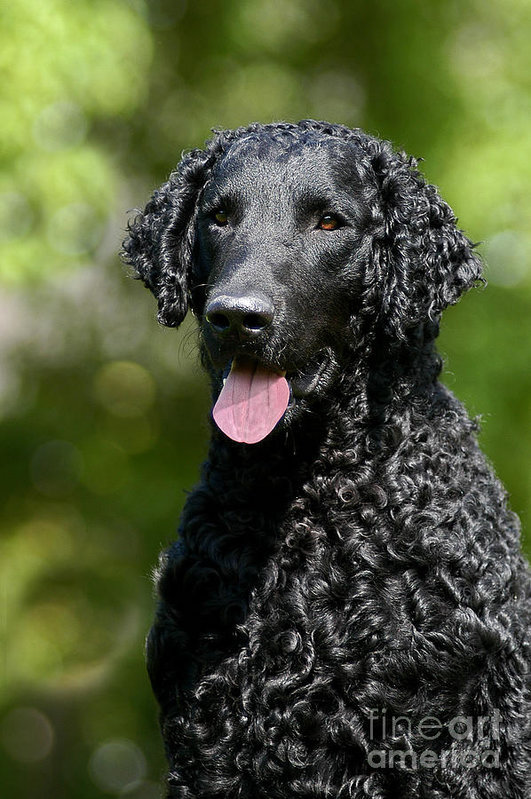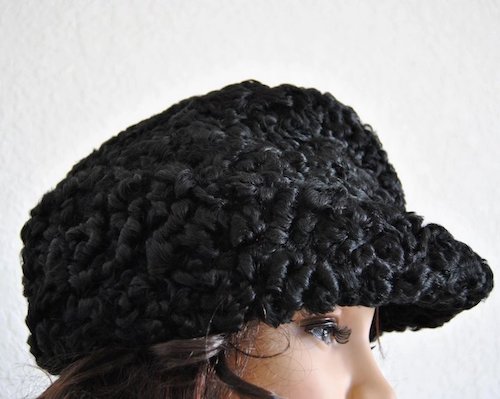
Retrievers are among the coolest dogs on the planet. Inclined to retrieve almost anything, their versatility seems to have few limits; they can be found detecting bombs, romping with kids, and hunting in woodlands or lakes. They sniff out drugs, lead the blind, and search for life in the rubble of a natural disaster. Retrievers do seem to be able to do it all.
That said, only two AKC retrievers have names defined by their hair shape (or follicles, to be technically accurate), the Flat-Coated Retriever, and the Curly-Coated Retriever, virtual opposites in the coat department, but interestingly, thought by some to both be descendents of the English Water Spaniel.
An ideal coat in the Flat-Coat is straight and lays flat. Any waviness should be slight in order to be permissible, but most assuredly, the coat is not wooly, short, silky or fluffy, and it’s definitely not curly.
Enter the Curly-Coated Retriever. His coat is supposed to be (wait for it) – curly, and not just curly (small c) but Curly (capital C), a thick mass of small, tight, crisp curls.
Not all curls are created equal. One dog might have tight crisp curls, another may have large soft open curls, and a third might be growing curls on the small and silky side. Some dogs have better coats as puppies, some dogs take an eternity to grow coat, and some never do get a correct coat.
And then there is the matter of undercoat. There isn’t any. Without an undercoat, the breed looks (how to say this….) not as good when they “drop coat” as they do otherwise. Most Curlies aren’t shown at a dog show until the coat grows back, and how owners handle this varies from owner to owner: Some take to clippers to even out the coat, others just comb out the dead hair and wait. Some do nothing at all and bide their time. Pity the breeder whose bitch goes bald after a litter of puppies!
And as far as we can tell, patience isn’t just a virtue in this breed, it’s a necessity. Most Curlies are in possession of their grown-up coat by the age of two, but other dogs can fall on either side of that age when getting their adult coats. If all goes well, what a magnificent coat the Curly has! A riot of crips, tight curls that the worst kinds of weed fail to penetrate. Resilient, water resistant, and protective, the curls go all the way up the neck to the dog’s occiput, down the thigh and back leg to at least the hock, and over the entire tail. The coat on the face, front of the legs and feet is smooth, and curls start at the top of the skull and form either a “V” shape or a curved shape called a “bonnet.”
Some people have likened the Curly’s coat to Astrakhan, the tightly curled fleece of a newborn karakul lamb (or fabric that imitates Astrakhan’s looped surface). It can be downright pricey when it’s a garment or hat. The Astrakhan Karakul Lamb cap below was marked down from $450 $225, and you can buy it here.

Author, David Hancock, has opined that if the astrakhan coat isn’t there neither is the Curly-Coated Retriever. He adds that the distinction is reinforced by the fact that the Curly is the tallest retriever with a silhouette all his own.
What say you, Curly owners?
Image: Portrait Black Curly Coated Retriever by Dog Photos is available as wall art, home decor and lifestyle items here.

Curly Coated Retrievers have both primary and secondary hair follicles, meaning they have two types of coat. Just as all other breeds do. Please understand: there has never been a dog breed yet that hasn’t had both primary and secondary hair follicles.
Curly coated retrievers used to be about the same size as Wavy-coats (now known as Flat coated retrievers). That was 24 inches at the withers. The new heights of the Curly Coated retriever are a modern development, circa after the First World War.
I suggest you contact canine hair follicle experts regarding coat and hair follicles and primary and secondary hairs.
Not all bitches go bald after having puppies. That is because genetics determine the number of primary and secondary hairs growing out of each follicle and also what stage of growth each hair follicle is in. So some curly bitches always have hair even after whelping puppies.
Thanks for your comment, Janean, it’s most welcomed. Might you be able to recommend canine hair follicle experts we might consult?
We don’t think we said that every bitch goes bald after puppies, we simply pity the ones that do. Our pity is borne of personal experience. As you said, not every bitch goes bald after whelping, and this is true in our own breed, the Puli, as well. Unfortunately, we were the owners of one of the four or five Pulik we know of who dropped every cord on their body in the days following birthing. It effectively retired her from the show ring long before her time.
All Bitches lose “some” of their coat after a litter(my aussies lost their breeches, at least). I don’t know the reason why for sure, Hormones, most likely. I know everyone of mine did. Sure some more than others, but never bald! My Grandfather in Iowa, owned a curly coated retriever……………..named Curly of course!